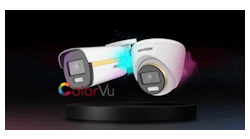Organizations that are still dependent on analog technology and not yet operating with versatile IP systems are increasingly handicapped in their day-to-day operations. For educational and government organizations, the ability to respond to emergencies and regulate access are hampered by low-resolution imaging and the limitations of decentralized control centers. For places of business, competitors using IP solutions are enjoying the advantages that high-definition clarity and cloud-based recording bring to loss prevention efforts, for example.
Whatever the security environment, IP’s capabilities, growing standardization and increasing affordability make adoption the only real choice —the question is, how to get your clients to make the transition.
“Simplicity” and “affordability” appear to be highly subjective terms. When it comes to replacing an obsolete multi-component system that is relied on for day-to-day functions, what is simple and affordable for a large business may not seem so painless to a smaller establishment. Thankfully, the nature of IP’s architecture allows for a measured transition, which, in the end will provide businesses and institutions with unprecedented flexibility for improving their integral security systems.
A measured transition breaks down the largest perceived barriers to obtaining an IP system. An integrator can help customers’ loss prevention or security teams facing limited budgets by laying the groundwork today for an eventual full IP conversion.
Measured Transitions Control Costs
A measured transition means a carefully-paced conversion. This is critical for many businesses and institutions that simply cannot afford an immediate full-system switchover, or for those that have relatively new analog equipment. A measured transition is the answer to both scenarios.
IP’s adaptability means there is no need to rip out all of the old cameras and recorders. A loss prevention or security team can decide to swap out strictly their oldest components, or strategically replace individual analog cameras with IP units in areas that require special attention. The combined technology will form a hybrid system that will work seamlessly. Each transplant will dramatically increase the capabilities of the loss prevention or security team.
A courthouse using analog fixed box cameras and key-operated locks, for example, can budget their IP transition according to priority. If the need to regulate admittance to certain areas of the courthouse currently outweighs the need to obtain high-quality video, the integrator can set-up a standalone IP access control system, which can be used alongside the analog camera system. The next step, when the budget allows, would be to unify the access control system with the analog camera CCTV by incorporating an NVR and security platform system. The integrator can later expand this hybrid system by switching out the analog cameras with IP models.
Every improvement goes at the security team’s pace, with an emphasis on controlling cost while focusing on the courthouse’s immediate needs.
For a retail loss prevention chief who recognizes the enormous potential of IP technology, a hybrid system has many benefits. Equipment replacement can be a tough sell to executives and stakeholders without clear financial advantages. A partial, measured transition can demonstrate the benefits and provide a return on the initial investment without requiring a full conversion commitment. The hybrid solution of IP and analog technology working side-by-side can provide solid comparative evidence of IP’s benefits — building a strong case for future IP upgrades.
Schedule Control
Reduced downtime allows for better scheduling. Because individual cameras and components can be swapped out quicker and easier than converting the entire system, LP and security teams benefit from the minimal impact of installations on day-to-day operations.
The finer detail and a greater field-of-view of IP cameras also work toward a smoother transition. For example, a big box retailer with a line of cameras monitoring the POS stations may now have the option of replacing three analog cameras with one well-placed IP unit. The retailer can choose to have the upgrade performed during non-peak times, and could schedule cashiers to operate registers outside the work zone. The old cameras can work in conjunction with the new to form redundancies that ensure no register is unmonitored during the changeover, even during business hours.
IP’s architecture also provides conversion scheduling flexibility. For example, an educational facility may decide to wait to switch out a section of cameras to coincide with another renovation. If the area is scheduled to receive a new lighting grid that has different power demands than the one prior, that might be a good time to upgrade the cameras to IP. With the IP cameras operating on power over Ethernet (PoE), the old dedicated power supply can now be rerouted for the new lighting, freeing up breakers in the process.
Allow for Business Evolution
LP and security systems need to evolve with the organizations that employ them; however, many businesses and institutions find themselves in a state of constant flux, making it difficult to pin down the specific shape their IP systems will need to take.
An integrator can help a business start laying the groundwork for the eventual implementation of a future IP system. Even if the organization has no immediate plans to start incorporating IP components, for example, it can opt to switch out the coaxial cable of its current analog system with new CAT5 line. A balun will enable old cameras to still send analog signals over the new lines — which will eventually serve as the nerves of an IP system.
A regional hospital with a modest budget for updating its security system has many options with a measured transition. By taking the institution’s projected growth into consideration, the security team may decide that the hospital would be best served by keeping the current video recorder and just replacing the cameras with IP models. Or, if there are future plans to acquire new branch clinics, ensuring fast emergency response times may be a priority. The customer may want to reserve the ability to one day unify its current system with those of the new clinics. In this situation, the integrator should recommend a partial camera conversion paired with the integration of an NVR. As clinics are acquired, their NVRs can be integrated to bring them under the single security umbrella. Response times to emergencies would be kept low as situations could be monitored from any location, and camera images and floor plans could be accessed by authorities.
Scalability
IP’s scalability also lends itself to incremental transition. IP networks can host one, 100 or even 100,000 cameras each. The benefits of scalability are clear when a single store that operates with a 15-camera setup today may grow to 60 stores in the coming years.
Knowing that adding cameras when needed will not require a full reconfiguration of the CCTV network relieves the pressure of having to see too far into the future to meet the needs of today.
Gerald Becker is vice president for physical security at USS (http://ussinnovate.com), a California-based integrator of IP video and access control systems. Please email him at [email protected], or follow him on Twitter, @Gerald_USS.


